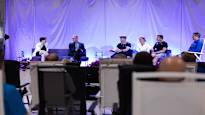During Vuokatti’s top sports week, the shortcomings of the Finnish sports system were brought up. According to Henrika Backlund, no one dares to discuss who controls elite sports.
Criticism of the Finnish Olympic Committee’s centralization of power and the failure to deal with the external assessment of elite sports continues. Now the Olympic Committee tells how it responds to it and develops its activities both in elite sports and in the sports and sports network.
General secretary of Finlands Svenska Idrott, the central Finnish-Swedish sports and exercise organization Henrika Backlund Finland, during Vuokatti’s top sports week, the leadership of the Olympic Committee had strict words.
– No one dares to discuss who controls elite sports and how, Backlund said.
There are also issues raised by Backlund In the external evaluation of Finnish top sports: The management system and forms of management of the Olympic Committee do not correspond to the network-like nature of the sports system. According to the evaluation, strict top-down management arouses mistrust in the network.
Director of elite sports of the Olympic Committee Matti Heikkinen recognizes many of the issues raised by both Backlund and the external assessment of Finnish elite sports.
– Bold openings. You shouldn’t be afraid here, and you really don’t want to shut anyone’s mouth. We want all the fresh ideas out there. There cannot be only criticism, there must also be solutions.
A new strategy for elite sports is underway
The Olympic Committee manages two large entities: elite sports and the sports and sports network.
In both, significant change and clarification work is underway.
The Olympic Committee is building a new strategy for elite sports. In terms of elite sports, more responsibility is transferred to the different levels of the networks: responsibility for coaching has been transferred to the Vierumäki sports center, and for the development of sports competence to the network of sports colleges.
– I would sum it up so that we are between the past and the future both in Finnish top sports and actually in terms of exercise and sports as a whole, Heikkinen states.
Alla Heikkinen talks about conflicting management expectations and the ongoing strategy work in elite sports.
For example, the preliminary results of the evaluation of para sports revealed that it was unclear to the network and actors who they had the leadership responsibility for.
– It is important to look at where that power and responsibility is and despite that we are able to do network-like activities together.
The exercise and sports network is unclear
An extensive research is being done on the exercise and sports network. The goal is to describe the task, goal and role of each part of the network and to find out what common services could be organized for all members of the network. In addition, the network’s needs for change are mapped.
Administrative Director of the Olympic Committee Emilia Ottelan According to
In the background materials of the report, which is still in progress, it is stated that joint services could include financial administration, personnel and IT administration, procurement, and support activities for training and social activities.
The work is in progress. Ottela emphasizes that the Olympic Committee does not decide on matters alone.
Emilia Ottela talks with audio about the mission of the Olympic Committee and the ongoing investigation of the exercise and sports network.
The membership includes 89 member organizations, 30 partner members and four individual members. Finlands Svenska Idrott is also involved in decision-making.
Matti Heikkinen, director of elite sports, states that nowadays it is quite easy to live and be. You don’t need to move if you don’t feel there’s a reason for it.
– In that sense, maybe our management systems and ways of thinking should be updated with this.
